#JavaScript Simplified
Explore tagged Tumblr posts
Text
Understanding ES6 Modules: A Beginner’s Guide to JavaScript’s Powerful Feature
New Post has been published on https://freelancingdiary.com/understanding-es6-modules-a-beginners-guide-to-javascripts-powerful-feature/
Understanding ES6 Modules: A Beginner’s Guide to JavaScript’s Powerful Feature
Demystifying ES6 Modules: A Practical Walkthrough
JavaScript has evolved significantly over the years, and one of its most powerful advancements in recent times is the introduction of ES6 modules. These modules bring a new level of clarity and structure to JavaScript codebases, making it easier to organize, maintain, and share code among projects.
What Are ES6 Modules?
ES6 modules are a way to encapsulate code into small, reusable pieces. They allow developers to export parts of a module (like classes, functions, or variables) and import them in other modules, promoting a cleaner and more modular code structure.
A Look at the Code
Let’s dive into an example to see ES6 modules in action:
File: main.js
JavaScript
import User, printAge, printName from "./new.js"; let sahil = new User("Sahil Ahlawat", 10); printAge(sahil); printName(sahil);
File: new.js
JavaScript
export default class User constructor(name, age) this.name = name; this.age = age; export function printAge(user) console.log(`Age of user is : $user.age`); export function printName(user) console.log(`Name of user is : $user.name`);
In new.js, we define a User class and two functions, printAge and printName. We then export these so they can be used in other files. In main.js, we import these exports and use them to create a new User object and print its details.
Setting Up Your package.json
To ensure Node.js treats our .js files as ES6 modules, we need to add a "type": "module" line to our package.json:
File: package.json
JSON
"name": "modules", "version": "1.0.0", "description": "Modules tutorial", "type": "module", "main": "main.js", "scripts": "test": "echo \"Error: no test specified\" && exit 1" , "author": "Sahil Ahlawat", "license": "ISC"
With this setup, running node main.js will execute our code with ES6 module support.
Benefits of Using ES6 Modules
Reusability: Code can be shared across different parts of an application or even different projects.
Maintainability: Clearer project structure makes it easier to manage and update code.
Namespace: Avoid global namespace pollution, which can lead to fewer bugs.
Conclusion
ES6 modules are a significant step forward in JavaScript development. They offer a robust way to organize code, making it more readable and maintainable. By embracing this feature, developers can improve their workflow and create more scalable applications.
This blog post provides a clear explanation of ES6 modules, demonstrates their usage with your code, and explains how to set up a Node.js project to use them. It’s written in an accessible way that should appeal to both beginners and experienced developers alike.
0 notes
Text
Essentials You Need to Become a Web Developer
HTML, CSS, and JavaScript Mastery
Text Editor/Integrated Development Environment (IDE): Popular choices include Visual Studio Code, Sublime Text.
Version Control/Git: Platforms like GitHub, GitLab, and Bitbucket allow you to track changes, collaborate with others, and contribute to open-source projects.
Responsive Web Design Skills: Learn CSS frameworks like Bootstrap or Flexbox and master media queries
Understanding of Web Browsers: Familiarize yourself with browser developer tools for debugging and testing your code.
Front-End Frameworks: for example : React, Angular, or Vue.js are powerful tools for building dynamic and interactive web applications.
Back-End Development Skills: Understanding server-side programming languages (e.g., Node.js, Python, Ruby , php) and databases (e.g., MySQL, MongoDB)
Web Hosting and Deployment Knowledge: Platforms like Heroku, Vercel , Netlify, or AWS can help simplify this process.
Basic DevOps and CI/CD Understanding
Soft Skills and Problem-Solving: Effective communication, teamwork, and problem-solving skills
Confidence in Yourself: Confidence is a powerful asset. Believe in your abilities, and don't be afraid to take on challenging projects. The more you trust yourself, the more you'll be able to tackle complex coding tasks and overcome obstacles with determination.
#code#codeblr#css#html#javascript#java development company#python#studyblr#progblr#programming#comp sci#web design#web developers#web development#website design#webdev#website#tech#html css#learn to code
2K notes
·
View notes
Note
i'm curious about something with your conlang and setting during the computing era in Ebhorata, is Swädir's writing system used in computers (and did it have to be simplified any for early computers)? is there a standard code table like how we have ascii (and, later, unicode)? did this affect early computers word sizes? or the size of the standard information quanta used in most data systems? ("byte" irl, though some systems quantize it more coarsely (512B block sizes were common))
also, what's Zesiyr like? is it akin to fortran or c or cobol, or similar to smalltalk, or more like prolog, forth, or perhaps lisp? (or is it a modern language in setting so should be compared to things like rust or python or javascript et al?) also also have you considered making it an esolang? (in the "unique" sense, not necessarily the "difficult to program in" sense)
nemmyltok :3
also small pun that only works if it's tɔk or tɑk, not toʊk: "now we're nemmyltalking"
so...i haven't worked much on my worldbuilding lately, and since i changed a lot of stuff with the languages and world itself, the writing systems i have are kinda outdated. I worked a lot more on the ancestor of swædir, ntsuqatir, and i haven't worked much on its daughter languages, which need some serious redesign.
Anyway. Computers are about 100 years old, give or take, on the timeline where my cat and fox live. Here, computers were born out of the need for long-distance communication and desire for international cooperation in a sparsely populated world, where the largest cities don't have much more than 10,000 inhabitants, are set quite far apart from each other with some small villages and nomadic and semi-nomadic peoples inbetween them. Computers were born out of telegraph and radio technology, with the goal of transmitting and receiving text in a faster, error-free way, which could be automatically stored and read later, so receiving stations didn't need 24/7 operators. So, unlike our math/war/business machines, multi-language text support was built in from the start, while math was a later addition.
At the time of the earliest computers, there was a swædir alphabet which descended from the earlier ntsuqatir featural alphabet:
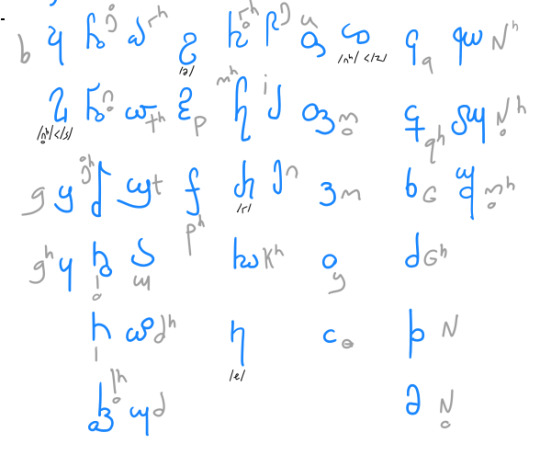
the phonology here is pretty outdated, but the letters are the same, and it'd be easy to encode this. Meanwhile, the up-to-date version of the ntsuqatir featural alphabet looks like this:
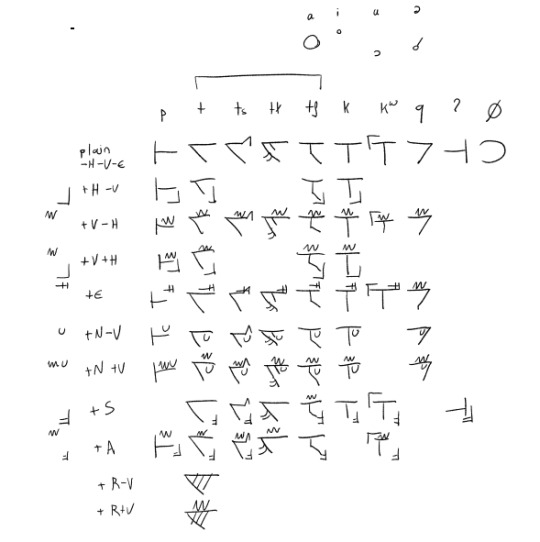
it works like korean, and composing characters that combine the multiple components is so straightforward i made a program in shell script to typeset text in this system so i could write longer text without drawing or copying and pasting every character. At the time computers were invented, this was used mostly for ceremonial purposes, though, so i'm not sure if they saw any use in adding it to computers early on.
The most common writing system was from the draconian language, which is a cursive abjad with initial, medial, final and isolated letter shapes, like arabic:
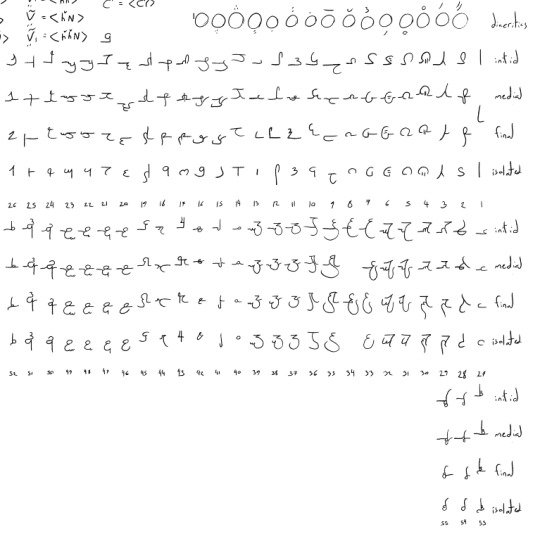
Since dragons are a way older species and they really like record-keeping, some sort of phonetic writing system should exist based on their language, which already has a lot of phonemes, to record unwritten languages and describe languages of other peoples.
There are also languages on the north that use closely related alphabets:

...and then other languages which use/used logographic and pictographic writing systems.

So, since computers are not a colonial invention, and instead were created in a cooperative way by various nations, they must take all of the diversity of the world's languages into account. I haven't thought about it that much, but something like unicode should have been there from the start. Maybe the text starts with some kind of heading which informs the computer which language is encoded, and from there the appropriate writing system is chosen for that block of text. This would also make it easy to encode multi-lingual text. I also haven't thought about anything like word size, but since these systems are based on serial communication like telegraph, i guess word sizes should be flexible, and the CPU-RAM bus width doesn't matter much...? I'm not even sure if information is represented in binary numbers or something else, like the balanced ternary of the Setun computer
As you can see, i have been way more interested in the anthropology and linguistics bits of it than the technological aspects. At least i can tell that printing is probably done with pen plotters and matrix printers to be able to handle the multiple writing systems with various types of characters and writing directions. I'm not sure how input is done, but i guess some kind of keyboard works mostly fine. More complex writing systems could use something like stroke composition or phonetic transliteration, and then the text would be displayed in a screen before being recorded/sent.
Also the idea of ndzəntsi(a)r/zesiyr is based on C. At the time, the phonology i was using for ntsuqatir didn't have a /s/ phoneme, and so i picked one of the closest phonemes, /ⁿdz/, which evolves to /z/ in swædir, which gave the [ⁿdzə] or [ze] programming language its name. Coming up with a word for fox, based on the character's similarity was an afterthought. It was mostly created as a prop i could use in art to make the world feel like having an identity of its own, than a serious attempt at having a programming language. Making an esolang out of it would be going way out of the way since i found im not that interested in the technical aspects for their own sake, and having computers was a purely aesthetics thing that i repurposed into a more serious cultural artifact like mail, something that would make sense in storytelling and worldbuilding.
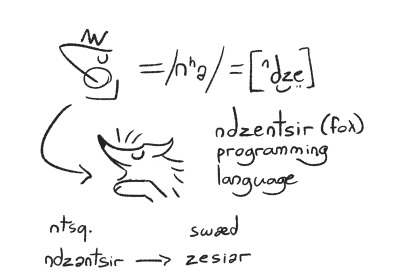
Now that it exists as a concept, though, i imagine it being used in academic and industrial setting, mostly confined to the nation where it was created. Also i don't think they have the needs or computing power for things like the more recent programming languages - in-world computers haven't changed much since their inception, and aren't likely to. No species or culture there has a very competitive or expansionist mindset, there isn't a scarcity of resources since the world is large and sparsely populated, and there isn't some driving force like capitalism creating an artificial demand such as moore's law. They are very creative, however, and computers and telecommunications were the ways they found to overcome the large distances between main cities, so they can better help each other in times of need.
#answered#ask#conlang i guess??#thank you for wanting to read me yapping about language and worldbuilding#also sorry if this is a bit disappointing to read - i don't have a very positivist/romantic outlook on computing technology anymore#but i tried to still make something nice out of it by shaping their relationship with technology to be different than ours#since i dedicated so much time to that aspect of the worldbuilding early on
13 notes
·
View notes
Text
decided to work on helping the non-fandom wiki since I was already dredging through code for an rp server by making a new list of simplified data
this is. an experience.

what the fuck is javascript dude I feel like such a fool coming in to ask multiple questions every time I need something specific. but we learnin.
#im like halfway done w/ the base stats then i gotta work on skills and what level they get them at#rpgmaker compressing EVERY LINE OF CODE WITH NO PARAGRAPH BREAKS OR SPACING. AUGH#look outside#rainne rambling
14 notes
·
View notes
Text
was just thinking to myself "there should be a social media app thats like a mini internet and the profiles are set up like websites and maybe the profile editor could have some kind of simplified coding or a simple tutorial so even non coders could use it and there would be more individuality and let everyone make their own ui to their own preferences. and people could make boxes on their page to put javascript in and make little games on their social media profile" and realized thats just what youd get if you combined neo/geocities, tumblr, and deviantart into one program and put it on a phone. which i think is still a better concept for a social media than any real one that exists right now. im imagining what it would look like right now i should be paid just for thinking of something thisgood
8 notes
·
View notes
Text
My jQuery Notes

Thought I would share my jQuery notes I made! jQuery is an open-source JavaScript library that simplifies the interactions between an HTML/CSS document, or more precisely the Document Object Model (DOM), and JavaScript!
Here are the resources I am using to make the notes:
FreeCodeCamp - LINK
W3School - LINK
The Documentation - LINK
GeeksForGeeks - LINK
Link to my Notion notes - ☆ LINK ☆
#my resources#resources#coding resources#codeblr#coding#progblr#programming#studying#studyblr#learn to code#comp sci#tech#programmer
78 notes
·
View notes
Text
What Is The Difference Between Web Development & Web Design?
In today’s world, we experience the growing popularity of eCommerce businesses. Web designing and web development are two major sectors for making a difference in eCommerce businesses. But they work together for publishing a website successfully. But what’s the difference between a web designers in Dubai and a web developer?
Directly speaking, web designers design and developers code. But this is a simplified answer. Knowing these two things superficially will not clear your doubt but increase them. Let us delve deep into the concepts, roles and differentiation between web development and website design Abu Dhabi.

What Is Meant By Web Design?
A web design encompasses everything within the oeuvre of a website’s visual aesthetics and utility. This might include colour, theme, layout, scheme, the flow of information and anything related to the visual features that can impact the website user experience.
With the word web design, you can expect all the exterior decorations, including images and layout that one can view on their mobile or laptop screen. This doesn’t concern anything with the hidden mechanism beneath the attractive surface of a website. Some web design tools used by web designers in Dubai which differentiate themselves from web development are as follows:
● Graphic design
● UI designs
● Logo design
● Layout
● Topography
● UX design
● Wireframes and storyboards
● Colour palettes
And anything that can potentially escalate the website’s visual aesthetics. Creating an unparalleled yet straightforward website design Abu Dhabi can fetch you more conversion rates. It can also gift you brand loyalty which is the key to a successful eCommerce business.
What Is Meant By Web Development?
While web design concerns itself with all a website’s visual and exterior factors, web development focuses on the interior and the code. Web developers’ task is to govern all the codes that make a website work. The entire web development programme can be divided into two categories: front and back.
The front end deals with the code determining how the website will show the designs mocked by a designer. While the back end deals entirely with managing the data within the database. Along with it forwarding the data to the front end for display. Some web development tools used by a website design company in Dubai are:
● Javascript/HTML/CSS Preprocessors
● Template design for web
● GitHub and Git
● On-site search engine optimisation
● Frameworks as in Ember, ReactJS or Angular JS
● Programming languages on the server side, including PHP, Python, Java, C#
● Web development frameworks on the server side, including Ruby on Rails, Symfony, .NET
● Database management systems including MySQL, MongoDB, PostgreSQL
Web Designers vs. Web Developers- Differences
You must have become acquainted with the idea of how id web design is different from web development. Some significant points will highlight the job differentiation between web developers and designers.
Generally, Coding Is Not A Cup Of Tea For Web Designers:
Don’t ever ask any web designers in Dubai about their coding knowledge. They merely know anything about coding. All they are concerned about is escalating a website’s visual aspects, making them more eyes catchy.
For this, they might use a visual editor like photoshop to develop images or animation tools and an app prototyping tool such as InVision Studio for designing layouts for the website. And all of these don’t require any coding knowledge.
Web Developers Do Not Work On Visual Assets:
Web developers add functionality to a website with their coding skills. This includes the translation of the designer’s mockups and wireframes into code using Javascript, HTML or CSS. While visual assets are entirely created by designers, developer use codes to implement those colour schemes, fonts and layouts into the web page.
Hiring A Web Developer Is Expensive:
Web developers are more expensive to hire simply because of the demand and supply ratio. Web designers are readily available as their job is much simpler. Their job doesn’t require the learning of coding. Coding is undoubtedly a highly sought-after skill that everyone can’t entertain.
Final Thoughts:
So if you look forward to creating a website, you might become confused. This is because you don’t know whether to opt for a web designer or a developer. Well, to create a website, technically, both are required. So you need to search for a website design company that will offer both services and ensure healthy growth for your business.
2 notes
·
View notes
Text
last night i sat down to work on my PCNY project again and i realized that i somehow forgot to implement marking a pokemon as seen or caught in the pokedex into my save editing code, so i went to go do that. i forgot how exactly that data was stored in the save file though, so i had to look up documentation on that on bulbapedia, and also reference my first attempt at implementing the same thing in my trader code.
back when i made my trader, for some reason i was working with hexadecimal and binary with values represented as strings...? it was my first time working directly with hex and i remember trying to look up how to do so in javascript and getting information on parseInt() and whatnot, so i guess i just assumed i had to work with strings...? i don't know, don't ask, i don't remember. the code for that tool is a mess as a result and i'd love to go back and redo it sometime with my new save editing code in play (and then i want to add features like swapping mail...! but that'll be a long time from now, probably)
anyway on top of all these values being strings, i also didn't really have an understanding of bitwise operators, which was a problem because pokedex seen/caught data is stored in bit arrays. to mark a pokemon as seen or caught, you have to flip a specific bit corresponding to the pokemon's national dex number to 1. since i was already working with strings, and i didn't understand bitwise operators, my code for that... looked like this

it... it works, but. um. yeah
now i just calculate the byte offset and the positioning of the bit that needs to be flipped (i need bitPos for something else later which is why i have it as a separate variable instead of putting num % 8 into the bitFlip line) and shift 1 that many times to the left, and then i go to that byte in the save data and do a simple OR ( | ) operation on it and the bitshifted 1, and that's it.


something i previously wrote a whole function for simplified down to two lines of code pretty much. suffice to say i have a better understanding of this now
12 notes
·
View notes
Text
and here it is.
arranged on Website as neatly as I could manage-- and, believe me, I got it looking neat.
this composition is unfinished just like the rest, but this time it's not on purpose. this one will be finished one day. it is an ongoing narrative, a good old-fashioned fictional Blog.
the writing style was selected in order to challenge myself, to push myself to be even clearer and even more lucid than ever before. this is inspired by Samuel Beckett's Molloy, a book that was a headache to read but felt inexplicably rewarding. you don't have to know Molloy to read composition no. 8, though. just, I suppose this is the closest I can really come to writing from a genuine "folksy" place. this is my folk. this is DJay Folk. immensely personal, local. this is the logical conclusion of the trajectory of the composition no. series.
the actual content was also selected in order to challenge myself. I want to mythologize the Weed Years, much as I would use Jordan Eats and Rapture to mythologize my early teenage years. the challenge here isn't necessarily in being honest and open about things, nor in dramatizing real events, but rather in putting words to processes that paralyzed me.
there's a much easier way to look at this, as this complicated set of requirements basically comes right around to describe a far more recognizable process:
this is poetry. old-fashioned, Symbolic-Surrealist, Metaphysical, every damn book I've taken interest in as an adult, poetry. I'm digging into my memories of the Weed Years and breaking it down into fundamental symbols and ideas. then I'm processing the interactions and crystallizing a genuine poetic point out of it.
the story itself openly acknowledges how and why this is so difficult.
I started writing this in 2021. I wrote a whole section of the story in 2023, then I only wrote one chapter of section 2 in 2024. in the past few days I have opened some notebooks and done some more rigorous preparation for what's to come.
hell, in all this time, we haven't even fucking made it to the Dolls yet. they keep getting brought up, it's obvious they will be a focus of the narrative. we kinda are coming close to them, though. I'm a little intimidated by the prospect, as I want the Dolls to capture a very specific undefined emotion. so I've gotta define that emotion first, then use the Dolls to make the reader feel it.
after the Dolls, there are some other upcoming structural elements I'm planning out at the moment. and eventually, the end of the story will involve the plot of my game Empty City, as I'd been meaning to fictionalize that one for a while. (it won't be a retelling of it, as Empty City is not about Jordan. but Jordan is a character in the game! and I want to explain what the fuck he's doing there.)
I do not know exactly how long this story will be. I would like it to be the length of a short novel, but I don't need to force that if the story doesn't call for it.
right, I guess I'll say some of the other kinds of things I say for all the other compositions.
so visually this blog feels more like an actual modern website. that's got to do with my decision to make the original blog using one of Blogger's newer dynamic styles, as Blogger will obviously try to use newer styles to capture a modern aesthetic. with this aesthetic, there is no image in the background, only a pleasant non-white color scheme.
I took the basic aesthetic of the original blog and simplified it further, removing the needless javascript and that confusing table of contents. the text is arranged neatly, as the priority here is the narrative experience, like a book. and even in the story so far, the text has drifted into "experimental" modes which offer a far more visual experience. I have been able to preserve those in the Website release.
there is also, rather front and center, a more obvious visual element. composition no. 8 will feature my art. I am actually drawing things for this story. so far we just have the "splash" image, foreshadowing the Dolls.

even just from this image alone, you can draw some conclusions and expectations for what the Dolls may end up being. the design of this Doll is based on the Rag Doll from composition no. 2. I knew I wanted to bring that dress back, I wanted to explore that Rag Doll idea.
I'll lay a couple more cards on the table here: I want composition no. 8 to be a scary story. I want the experience of reading it to be bizarre, considered, cerebral, and for it to feel like the reader has just kinda stumbled into horrors they haven't got the language for. maybe I just really want the composition no. blogs to have led to something substantial, something self-evidently worthy of being someone's favorite Internet Fiction. the same kinda thing I always want with my projects, but that's how I know this series is one of my projects: I'm getting optimistic about it!
and, like. what this story is so far is very dense prose getting at some very dense concepts through a short list of Symbols I find very aesthetically addictive.
the Dolls are one of those Symbols.
my self-insert is another.
EAT is another, and EAT does have a presence in this narrative, but it's indirect. EAT is the second-person this time. this story is being told to EAT.
and then there's the Eternal Mansions. they are related in some way to the Empty City. they may just be a geographical "feature" in the Empty City, I think that's a reasonable deduction. but if they are, they're the same Empty City that I made a game about, it's the Empty City as I myself see it. it's a land that doesn't really exist, and is just an allegory. but we must treat it as if it does, and feel around until we can identify some features this non-existent place actually has. it's a perfect place. it's not meant for humans.
composition no. 8 will continue. you can be sure of that. this is where it's currently at. I will update it on the Website and not the original blog. I mean, probably.
so this also means all eight installments of the series have been brought to the Website.
next up I need to make a unifying landing page for the series. that'll be much easier and will probably make use of these very rambles I've been putting on tumblr.
I'll see you when I see you. thanks for reading.
#my art#oh yeah. right. if you're wondering what 'material nostos' means.#nostos is homecoming. composition no. 8 is me telling the story of my coming home to the material world.#from a strenuous journey through symbolic abstractica.
4 notes
·
View notes
Text
Simplify MathML Authoring with Lightweight Syntax - Mathup
If you’ve ever wrestled with MathML, you know it can be… verbose. mathup is a JavaScript library that takes a more developer-friendly approach. It lets you write math using a syntax similar to AsciiMath and outputs MathML. This isn’t about replacing full-blown TeX rendering engines; it’s about making simple, everyday mathematical notation easier to manage in web projects. For example: you write…
2 notes
·
View notes
Text
Aamod ItSolutions: Crafting Custom Websites with Modern Technologies for Your Business’s Success
In today’s digital world, having an effective website is crucial for business success. Aamod ItSolutions offers expert web design, development, and marketing services that help businesses make the most of their online platforms. Our team of skilled designers and developers uses modern technologies to build custom, user-friendly, and reliable websites tailored to your specific needs.
Why Web Development Matters
A website serves as a business’s online identity. It enables businesses to reach a wider audience, engage with customers, and boost sales. A professionally developed website builds trust, enhances credibility, and positions your business as a leader in the market.
At Aamoditsolutions, we focus on delivering websites that provide excellent user experience (UX), performance, and scalability. We employ various modern technologies to ensure your site meets business goals efficiently.
Technologies We Use
Laravel: Laravel is a powerful PHP framework used for building secure, scalable web applications. It simplifies development with features like Eloquent ORM for database management and Blade templating for creating dynamic views. Laravel is great for complex applications with robust security features.
CodeIgniter: CodeIgniter is a lightweight PHP framework known for its speed and simplicity. It’s ideal for developers looking for quick setups and minimal configuration. With its MVC architecture, CodeIgniter is perfect for building fast, high-performance websites, especially when project deadlines are tight.
CakePHP: CakePHP is another PHP framework that streamlines the development process with built-in features like form validation and security components. It helps deliver web apps quickly without compromising quality. CakePHP is ideal for projects that need rapid development with a focus on database-driven applications.
Node.js: Node.js is a JavaScript runtime for building fast and scalable applications. It is especially useful for real-time web apps such as chat applications or live notifications. Node.js provides non-blocking I/O operations, enabling it to handle many simultaneous connections without performance loss.
AngularJS: AngularJS is a framework developed by Google for building dynamic, single-page applications (SPAs). Its features like two-way data binding and dependency injection make it perfect for building interactive user interfaces that update in real time without reloading the entire page.
Why Choose Aamod ItSolutions?
At AamodItSolutions, we use the latest tools and technologies to build high-performance, secure, and user-friendly websites that help you grow your business. Whether you’re a startup or a large corporation, we create custom solutions that align with your objectives.
We understand that every business has unique needs. That’s why we choose the right technology for each project to ensure optimum results. By working with us, you can expect a website that provides a seamless experience for your users and contributes to your business growth.
Let Aamod ItSolutions help you create a powerful online presence that engages customers and drives business success.
#cosplay#drew starkey#bucktommy#entrepreneur#harley quinn#jujutsu kaisen#english literature#black literature#blush#kawaii
3 notes
·
View notes
Text
pipe operator in js
Rescuing from my drafts ca march 2023. This is no longer actually true; my company folded last year and I'm back on my gamedev non-sense (bittersweetly!). More details on that soon.
Long time no post. I'm working in elixir these days; I couldn't sleep and so was catching up on modern JavaScript; I watched nerds snipe in the gutters.
what is pipeline?
You read this; you're adjacent to >=1 programmer. It's bash piping, the output from one function goes to the next.
There's a few ways to spell it, from the explicit:
const $0 = foo(input); const $1 = bar($0); const output = baz($1);
Explicit! Legible!
Cumbersome! Weave-y!
To the Hack-style syntax, where the pipe operator creates a variable within its right hand side's scope (sort of like this:
const output = input |> foo($) |> bar($)
Just sugar on top of the above (+ variable lifetime scopes, whatever)
Nobody can agree on the magical "previous expression result" symbol
when the pipe is a series of 1 arg f()s, the ($) extra characters are gross.
To the F#-style syntax, where the calls have to be arity-1 functions:
const output = input \|> foo \|> bar
Handles the happy path 1-arg f() beautifully
requires lambdas or currying and more care for every other case.
F# wins, right?
The community seems to think so.
But it has wrinkles; every method has to be 1-arg, and the hidden closures to enable that have performance impact.
My modest proposal
I wrote this because I didn't want to post on a six-year-and-counting language proposal, but I also had an idle fancy.
To me, the problem isn't a lack of a pipe operator or other functional support.
It's @#_-+&!ing left-hand assignment and community conventions.
You can even see it in the examples, where we have const foo, a bunch of really relevant details, and then wham, we're back to the start for the next line.
What we need is:
A right-hand assignment operator, so that after calculating a variable you can stick it somewhere. Without further thought, I propose =: but I'm sure there could be improvement.
=: assigns to the RHS, and to the special variable it. By default, assigns to _ (discards) -- in addition to it.
A new keyword & local variable "it". "It" is sort of like "this", with special rules about its meaning scoped to the function in which it appears. Typechecking must respect its most recent assignment (how high of a lift is this?!). Lambdas have their own standalone it (so you need to
A community that accepts using non-descriptive variable names & scoped type checkers for this purpose -- for instance, special syntax around right-assigning to $ such that it's type checkable, variable scoped, etc.
The semicolon "operator".
Then a pipe could be written:
input =:; foo(it) =:; bar(it) =: output
Potentially with parens in certain callsites, simplifying it a bit maybe, etc.
Things to improve:
It doesn't look like a pipe.
But is that so bad, when it makes the whole thing so beautifully explicit?
It breaks LHS/RHS naming and conventions (you're assigning?! To the right hand side??!). Doesn't delete foo[bar] do the same? This seems like a very core, very forgivable case to make the code match the language. I do not usually say "x takes the value seven"; I very often do say "store 7 as 'x'".
Real downsides: so many syntax highlighters, code awareness tools etc would need to understand polymorphic horrible "it". Combined with exceptions, the values of it in a catch clause feel pretty scary.
Still, food for thought.
2 notes
·
View notes
Note
Ahrah: @dragongirlcock encouraged us to tell you that we've recently made the permanent jump from Windows to Linux. Your post on the topic on top of the usual Microsoft bullshit was one of the catalysts to just do it now. We did play around with several different distros in 2013 in a dual boot system, so we already had a feel for a few different ones and what we prefer in a DE and whatnot. They were all Debian based, but then we happened to stumble across Garuda KDE Dr460nized, and aside from that we really like KDE Plasma, couldn't possibly pass up on a distro with that name XD Plus it has been nice having most gaming things working out of the box and generally saved us some floundering in figuring out what all we needed, bc things have come a long way since 2013.
We've been having bit of a time trying to learn the terminal and all, and have been running into miscellaneous issues, but it has been comforting to have more expirienced people we know look at them and go, "that problem is Weird wtf???"
Sometimes we'll go looking for info and the internet is like, "Ubuntu = Linux, especially if you're a newbie, and here's how to do things without having to touch the big scary terminal :) " and anything that might be helpful it feels like there's the expectation that you know everything already if you're on Arch. *angry dragon noises*
We feel like we've somehow happened to slip through the cracks of what people "typically" do or are encouraged to do when it comes to transitioning to Linux, why is this? Bc I feel that us having more of an interest in learning more shouldn't be that odd, it seems stranger to me that there seems to be a Windows vs Mac parallel with Debian vs Arch in terms of the general information available and expectations??? Also any recommentions on ways to just stumble upon things would be helpful. Bc sure we can got to the AUR, but you have to kind of already know what you're looking for.
hell yeah !!! welcome to The Community !! (programmer socks optional d: )
oooooohhh garuda !! recognised the name and is bc it's built atop arch !!
yeag, the ubuntu-as-default assumptions (which, annoyingly, even affects debian users sometimes) are frustrating. also the "commands scawy uwu" attitude (which also seems to include "just paste this magic command in the terminal dw it's totally fine :))))" from time to time) is frustrating as well.
i don't expect every single person to manually install arch, or like gentoo or smth, spend a week configuring it, and fuckign write an emacs port to run it as a full wayland compositor, but treating computers as Magical Boxes and users as Inherently Inept really gets my goat.
idk what good communities look like anymore bc i'm not part of any and solve shit myself or by asking friends/partners, but for arch, the official wiki tends to have most things well-explained. it's not a complete solution but it should help 🩷
in conjunction w/ the arch wiki, we use stackoverflow, man pages (documentation that doesn't require a website 7 months pregnant w/ javascript octuplets ? gooodddsss it feels good), package manager search, chaotic-aur (has most aur packages pre-compiled as an additional repo, so pacman can search and install them), tldr which is simplified man pages (very handy for example commands !!)
linux systems really are a thousand rats in a trench coat, so understanding what rats ya got helps but can take time. the best way round that is have a system you can break.
for like getting from ubuntu-coded to arch-coded, we're planning some GUIDEs that may be handy. wanna cover basic terminal and shell stuff, standard unix commands, what some of the bigger trenchcoat rats are and why.
until then, if there's any specific questions feel free to drop a message here or in DMs or wherever 🩷
4 notes
·
View notes
Text
What is Mern stack And Its importance? Before that I will Tell you the best institute for Mern stack course in Chandigarh.

What is Mern stack?
MERN Stack is a popular JavaScript-based technology stack used for building full-stack web applications. It consists of four key technologies:
MongoDB: A NoSQL database that stores data in a flexible, JSON-like format.
Express.js: A lightweight and fast backend framework for Node.js.
React.js: A front-end JavaScript library for building user interfaces.
Node.js: A runtime environment that allows JavaScript to run on the server side.
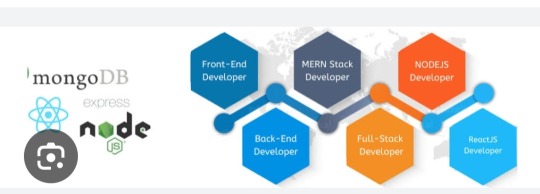
Importance of Mern Stack :
Full-Stack JavaScript – Uses JavaScript for frontend and backend, simplifying development.
High Performance – Node.js ensures fast, scalable applications.
Cost-Effective – Open-source, reducing development costs.
Rapid Development – React’s reusable components speed up UI building.
Flexibility – Suitable for web apps, SPAs, eCommerce, and real-time applications.
Scalability – MongoDB handles large data efficiently.
Strong Community Support – Large developer base ensures continuous updates and support.
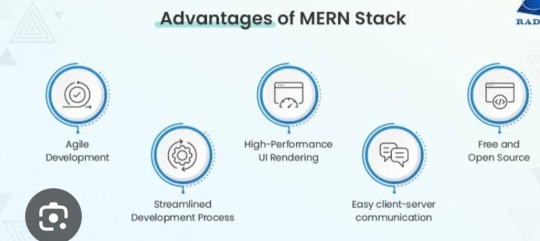
Now i will tell you the best institute for Mern stack course in Chandigarh .

Excellence Technology is a leading EdTech (Educational technology) company dedicated to empowering individuals with cutting -edge IT skills and bridging the gap between education and industry demands. Specializing in IT training ,carrer development, and placement assistance ,the company equipts learners with the technical expertise and practical experience needed to thrive in today's competitive tech landscape. We provide IT courses like python ,Full stack Development, Web Design ,Graphic Design and Digital Marketing.
Contact Us for more details: 93177-88822

Extech Digital is a leading software development company dedicated to empowering individuals with cutting -edge IT skills and bridging the gap between education and industry demands. Specializing in IT training ,carrer development, and placement assistance ,the company equipt learners with the technical expertise and practical experience needed to thrive in today's competitive tech landscape. e provide IT courses like Python ,Full stack Development, Web Design ,Graphic Design and Digital Marketing.
Contact Us for more details: 93177-88822

Excellence academy is a leading software development company dedicated to empowering individual with cutting edge IT skills and bridging the gap between education and industry demands.specializing in IT training, career development, and placement assistance, the company equits learners with the technical expertise and practical experience needed to thrive in today's landscape. We provide IT courses like python, full stack development,Web design, and Digital marketing.
Contact Us for more details: 93177-88822
About Author
Nikita Thakur
Mern stack AI Developer/ 2+ years of experience
Excellence technology
Professional summary
Nikita thakur is a skilled MERN Stack AI Developer with over 2 years of experience at Excellence Technology. Proficient in MongoDB, Express.js, React.js, and Node.js, she integrates AI solutions to build scalable, high-performance web applications. Nikita excels in developing innovative solutions, enhancing user experiences, and driving business growth through technology.
2 notes
·
View notes
Text
What Is a Dynamically Typed Language?
When learning Python, you might hear the term “dynamically typed language” frequently. But what does it mean? Let’s break it down.
Typing refers to type-checking—the process of verifying whether the data types in your code are compatible with the operations being performed.
1️⃣ Strongly vs. Weakly Typed Languages
Strongly-Typed Languages (e.g., Python): These languages don’t allow type-coercion (implicit type conversion). For example:
pythonCopy code"1" + 2 # TypeError: cannot concatenate 'str' and 'int'
Weakly-Typed Languages (e.g., JavaScript): These languages allow type-coercion:
javascriptCopy code"1" + 2 // Outputs: "12"
2️⃣ Static vs. Dynamic Typing
Type-checking can occur at two stages:
Static Typing (e.g., Java, C++): Data types are checked before the program runs. You must declare the type of variables explicitly:
javaCopy codeintx=10;
Dynamic Typing (e.g., Python): Data types are checked during program execution. Variable types are inferred automatically:
pythonCopy codex = 10 # No need to declare 'x' as an integer.
Python: A Dynamically Typed Language
Since Python is an interpreted language, it executes code line by line. Type-checking happens on the fly, allowing you to write flexible and concise code.
Example: pythonCopy codex = "Hello"x = 10 # No error—Python allows 'x' to change types.
This flexibility makes Python beginner-friendly but also increases the risk of runtime errors if types are misused.
Key Takeaway
Dynamic typing simplifies coding by removing the need for explicit type declarations. However, it also requires careful testing to ensure type-related bugs don’t creep in.
Python learners, embrace dynamic typing—it’s one of the reasons Python is so versatile and fun to use!
2 notes
·
View notes
Text
I tried to simplify ! NOT Operator in Javascript
Some concepts can be really tricky when seen in a larger context or used differently than the examples provided when you just read about them for the first time. It happened to me with the NOT operator, took me a while to figure it out but when I did I knew I had to write what I knew about it and of course share. Please readddddddd ! ✨✨
#codeblr#coding#tech#javascript#coding community#developer#web development#resources#code#programming#programmers
9 notes
·
View notes